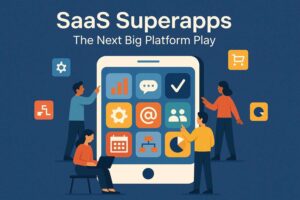-

Composable & API-First SaaS Architecture — Building Flexible, Modular SaaS Stacks
A clear guide to building SaaS with composable and API-first architecture. Learn how modular design improves flexibility, scalability, and long-term growth.
-

Low-Code + No-Code + AI: The Triple Threat Accelerating SaaS Growth In 2025
Low-code, no-code, and AI are reshaping SaaS development in 2025. Learn how this triple threat speeds up launches, cuts costs, and empowers lean teams.
-

SaaS Superapps: The Next Big Platform Play
Learn how SaaS superapps are reshaping software, why businesses want them, and what founders need to know about building multi-functional SaaS platforms.
-

Vertical SaaS: Why Niche Domination Beats Horizontal Scale in 2025
Discover why niche-focused vertical SaaS is outperforming broad platforms in 2025 — and how founders are scaling deeper, not wider.
-

The Rise of Micro-SaaS & Vertical SaaS: Niche Is the New Big
Discover why Micro-SaaS and Vertical SaaS are booming in 2025 — and how niche-focused software is reshaping the global SaaS landscape.
-

Why Conversational AI Might Replace Apps Completely
Discover why conversational AI may replace apps completely, what this shift means for SaaS, and how founders can prepare for the post-app era.
-

6 Industries Being Quietly Transformed by Conversational AI
Discover 6 industries being quietly transformed by conversational AI and the opportunities this shift creates for SaaS founders.
-

Conversational AI: The Future No One Is Ready For
Conversational AI is evolving fast. Discover the opportunities, risks, and how SaaS founders can prepare for a future no one is ready for.
-

10 Things ChatGPT AI Chatbots Can Do That Humans Can’t
Discover 10 things ChatGPT AI chatbots can do that humans can’t, from automation to empathy, and learn how SaaS founders can harness these superpowers.
-

Is ChatGPT AI Chatbot Really Smarter Than Google?
Is ChatGPT really smarter than Google? Discover how they compare in accuracy, reasoning, and impact for SaaS founders and users.
-

The Hidden Downsides of ChatGPT AI Chatbots Nobody Warns You About
Discover the hidden downsides of ChatGPT AI chatbots, from mental health risks to data privacy threats, and what SaaS founders must do to stay safe.
-

7 Surprising Ways Businesses Secretly Use ChatGPT AI Chatbots
Discover 7 surprising ways businesses secretly use ChatGPT—from consulting and tax advice to elder care, finance, and luxury retail.